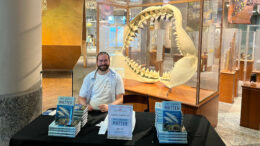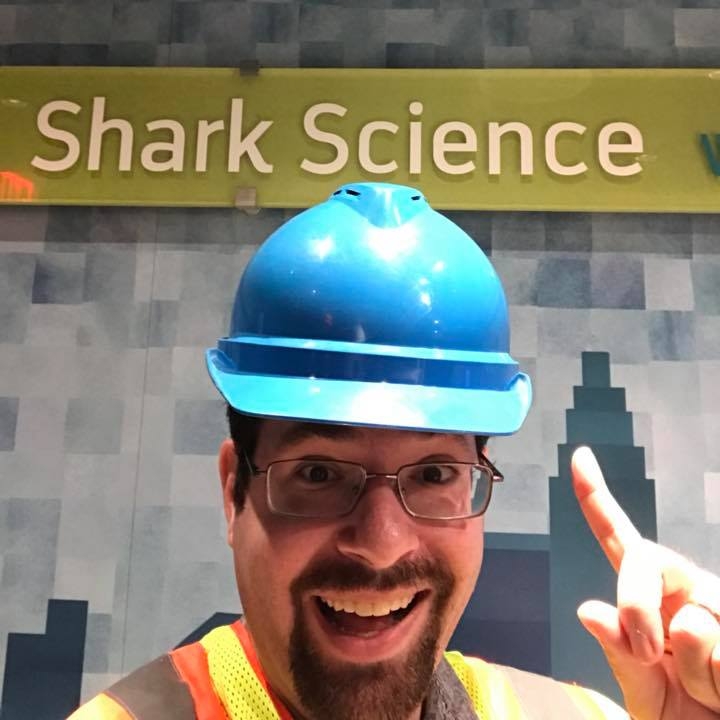As a shark scientist, I know the importance of generating public support for endangered, poorly understood or ignored species. That’s why I wrote my new book, Why Sharks Matter: A Deep Dive With the World’s Most Misunderstood Predator — to reach people I couldn’t through my technical papers, articles or conference presentations.
I spent almost 10 years writing the book, but as the publication date neared, I realized that was just the first step. I also needed people to know it existed so they could buy it, read it, and hopefully act on its recommendations.
My publisher has some resources to help with media interviews, but like most academic presses their promotional budget is limited. I knew that if I wanted to really get the book out there, I had to do it myself.
I decided that a book tour was the best option.
As I write this, I’m in a hotel room in Raleigh, North Carolina — stop number 28 on a 40-city (and growing) tour that’s already gone better than I expected. I’ve reached thousands of people, sold crates full of books, and spread the message that sharks are worth protection and conservation.
Yes, I did all the planning for this myself — it’s beyond the scope of an academic publisher — and I planned it all as environmentally mindfully as possible.
Here’s how I accomplished that.
Why I Wanted to Do a Book Tour
Authors always want people to read their books, but good scientific communicators embrace the principle of “double dissemination” — telling the same story in multiple ways, and possibly different formats, for varied audiences.
I knew going into this tour that some folks would be more receptive to my book’s “here’s how we have to change our behaviors to save the planet” arguments if they heard them delivered persuasively by an expert speaker. That’s why the public-speaking component of a tour helps the cause I care about so deeply.
I love public speaking. Standing on a stage in front of a live audience has been a welcome break from giving talks into my webcam from my living room. They’re a lot more exciting, too. Each of my talks includes a Q&A component, which lets people ask me anything they want to know about sharks, marine biology or ocean conservation. You never know what you’re going to get asked, so this is also a good test of your ability to speak off the cuff.
The book tour has also, obviously, helped to drive book sales, both in person and through media and social media attention that sold even more books elsewhere.
Doing some media during the lunch break pic.twitter.com/ilUZNs1hRM
— Dr. David Shiffman (@WhySharksMatter) October 22, 2022
I had a few additional, personal reasons for the tour.
After the past couple of years, I’ve really missed travel. As an academic, some of my closest friends are now scattered all over the world. Work travel lets me visit places (and people) where I used to live and now miss, and it lets me go to some places where I’ve never been and have always wanted to visit. I wanted to do more of that.
I certainly got to — but that came with challenges.
Balancing the Environmental Impact of Travel
Travel, especially air travel, has an environmental impact that we can’t ignore.
I don’t believe that the answer is “never travel if you care about the planet,” but instead to be thoughtful and strategic about it. For me, flying halfway around the country to give a half-hour talk is neither thoughtful nor strategic.
Instead I rely heavily on a concept introduced to me in Brett Favaro’s book The Carbon Code: If you can’t minimize your carbon footprint, maximize the value you get out of it. Do more than one thing per trip.
That meant sometimes building a book tour talk into trips to places I was already going. For example, I attended a conference in Spokane, Washington this summer, so I also gave a public talk there and added on side trips with talks in nearby Seattle, Victoria and Vancouver, British Columbia. (I used to live in Vancouver, so this also let me catch up with friends and colleagues while I was there.) The only flights associated with this trip were to Spokane and home from Canada.
I also planned regional swings, often centered around an anchor point. Some venues don’t really care when I speak, while others have a particular date in mind (or were based around work events like scientific conferences with fixed dates). In those cases, I’d make sure to be in the area when the venue needed me, then reach out to other nearby venues and say, “Hey, I’m in town for X and free these days to give a talk.”
That allowed me to limit my coast-to-coast flights to one round trip. I flew to California once and visited five cities while in the area.
Throughout the tour, I’ve flown as little as possible. Sometimes this meant trains, while other times it meant driving. My personal rule is if I can get there in less than six hours of driving, I won’t fly. Your (literal) mileage may vary here.
How I Arranged It
I’m an experienced public speaker and I’ve developed an extensive network of contacts from years of conferences and professional events. I also have a significant social media following and contacts with folks who run social media for venues all over the world. All of this is to say that some of this was easier for me to arrange than it might be for you — but the basic principles should work for anyone interested in planning similar events.
The basic model of my talk was a 30- to 40-minute presentation, followed by a Q&A, book sales and signings. I mostly worked with zoos, aquariums and science museums, as well as a few universities with public lecture series, bookstores that do author events, and libraries.
Step one was to lock down the anchor talks. I started by using social media and emails to announce that I was planning a book tour and inquire if anyone had interest in hosting me.
Here’s the important lesson I learned: I don’t reach out randomly to anyone who lives in a town I hope to visit. I start with people I already know who work for venues that might be interested in the type of events I’m offering. If I knew of a venue but didn’t know anyone who worked there, I used social media to ask if anyone could connect me. This avoided the need to cold call anyone.
Once I had anchor talks in place, I started looking into nearby cities and venues. I asked my connections something like “I have a talk at South Padre Island on X dates and I’m interested in event venues in nearby cities and towns — do I know anyone with contacts at venues in Corpus Christi, Port Aransas, etc.”
My contacts had another key role: Local champions have helped bring me to their areas and arrange logistics, including meet and greets with local scientists and students. Many helped arrange housing and other accommodations, including some meals and rides from the airport.
The Economics
Academic publishers don’t pay for things like this. At my book’s intentionally affordable price point of $25, a tiny portion of which goes to the author, I would need to sell a lot of books to cover the costs of even one of my trips. (Venues usually sell my books directly, or through a partnership with a local bookstore, to avoid me having to carry books around the world.)
So how does it work? Simple: The venues pay my speaking fee and travel expenses. We negotiate based on venue size and resources — a rural public library wouldn’t have the same events budget as a large city science museum. But on every one of my regional legs, I made more in speaker fees than it cost me to get there — often substantially more.
As an academic I can take advantage of another way to pay for me travel costs: departmental research seminars. I was able to get to several cities because a university brought me out to speak about my research to their students and staff. Then, while I was nearby, I could arrange events at smaller public-facing venues.
Also worth noting: I kept my day jobs and worked remotely while on the road, although I sometimes had to take half days to account for travel.
Pros and Cons
As of this writing I’m about three-quarters through the originally planned 2022 book tour, and I’ll extend it through 2023 in some capacity. I had feared that I might be burned out by now, and I need to tell you — I’m not. I’ve visited friends and colleagues I haven’t seen in years and visit traveled to places I used to live and now miss.
I’ve also gotten to tour tons of wonderful museums, zoos and aquariums and chat with some fascinating people.
My book has taken me to some pretty cool places! Currently eating fish and chips overlooking the Tower of London. pic.twitter.com/cSiLRHC9xl
— Dr. David Shiffman (@WhySharksMatter) October 25, 2022
And there’s nothing like a live audience who appreciates what you have to say. I love this.
When the tour is all over, I’ll be thrilled that I did it and look back fondly on the memories I made.
But I do miss sleeping in my own bed, and I haven’t seen some friends at home for a while. Planning this tour has been a ton of work. While I’ve avoided burnout, being on the road living out of a suitcase and eating unhealthy roadside food and visiting tons of different time zones all takes its toll.
I can’t imagine I’ll ever do anything like this again.
Unless the sharks still need me, of course.
Get more from The Revelator. Subscribe to our newsletter, or follow us on Facebook and Twitter.
![]()


